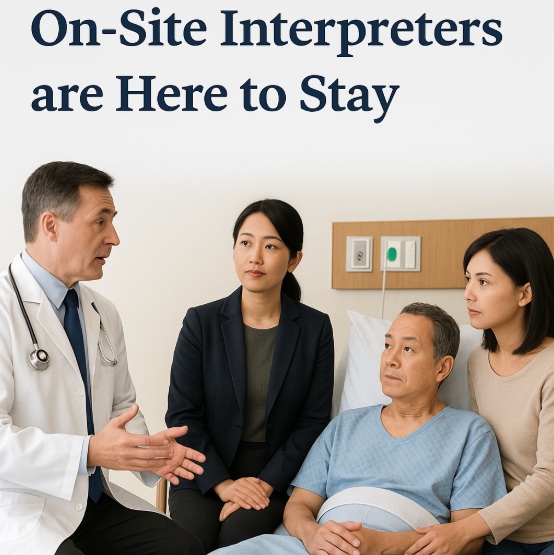
Table of Contents
Beyond the Screen: The Enduring Value of On‑Site Interpreters
How organizations can choose the right modality—and why on‑site remains mission‑critical in high‑stakes communication.
A cardiologist is explaining risks before an urgent procedure. The patient’s spouse is anxious, asking rapid‑fire questions. The interpreter sits at the foot of the bed—eyes up, posture open—mirroring tone, pacing the exchange, and gently cueing turn‑taking. Subtle pauses and nods keep the conversation humane and accurate. Nothing drops. Nothing distorts. Everyone leaves aligned.
Remote interpreting has expanded access and speed in remarkable ways. But moments like these—complex, sensitive, and deeply human—are where on‑site interpreting shines. Here’s when and why face‑to‑face isn’t just preferable; it’s essential.
Quick Answer for Skimmers
Choose on‑site for high‑stakes, sensitive, or complex interactions where nonverbal cues, rapport, and environmental control materially affect outcomes.
Typical on‑site candidates: legal proceedings, informed consent, behavioral health, ASL assignments, safety trainings, crisis response, and any setting with noise, movement, or larger groups.
Use remote—over‑the‑phone interpreting (OPI) or video remote interpreting (VRI)—for short, transactional touchpoints, after‑hours access, rare languages on short notice, or surge/overflow.
What On‑Site Really Delivers
Nonverbal fidelity & full context
Words are only part of what’s said. On‑site interpreters read posture, micro‑expressions, side conversations, and the environment itself—lighting, noise, seating—to calibrate register, tone, and pacing. That fidelity keeps nuance intact, especially when emotions run high.
Rapport & trust in the room
Presence builds credibility. In behavioral health, end‑of‑life care, restorative justice circles, employee relations, and family meetings, trust is the channel. On‑site interpreters help create a rhythm that encourages participation, reduces fear, and validates concerns without becoming part of the story.
Environmental control
Seating plans, sight lines, acoustics, and discreet hand signals reduce errors and protect confidentiality. The interpreter can position themselves so all parties see and hear cleanly, and they can signal for repetition or slower pacing without derailing the moment.
Reliability under pressure
On‑site has fewer technical failure points than bandwidth‑ and device‑dependent setups. If Wi‑Fi falters or a camera freezes, the conversation doesn’t. Continuity matters when the stakes are high.
Interpreter performance
Complex, long, or emotionally heavy assignments tax cognition. On‑site work typically imposes a lower cognitive load than multi‑screen remote configurations, supporting stamina, accuracy, and ethical practice over hours—not just minutes.
Where On‑Site Outperforms
Healthcare & social services: informed consent, complex diagnostics, labor and delivery, trauma intake, behavioral health sessions, child welfare interviews.
Legal & courts: hearings, trials, depositions, attorney‑client meetings, police interviews, asylum screenings; physical presence supports chain‑of‑custody confidence and reduces disputes.
Education: IEP/504 meetings, parent‑teacher conferences, classroom support, school psychology evaluations where emotions and stakes are high.
Deaf/Hard‑of‑Hearing (ASL and other signed languages): signed languages rely on spatial grammar and clear sight lines; dynamic groups and emergencies are safer in person.
Public sector & emergency response: disaster briefings, field operations, community town halls; presence boosts clarity, trust, and equitable participation.
Enterprise & events: executive negotiations, performance reviews, plant walk‑throughs, safety trainings, live events and press conferences where noise and movement are factors.
Rule of thumb: If the conversation can change a life, liberty, or livelihood, choose on‑site.
When Remote Shines (and How to Use It Well)
Remote interpreting is a vital part of a modern language‑access program. Use it intentionally.
Short, transactional interactions: routine check‑ins, quick questions, appointment confirmations.
Access and speed: after‑hours needs, rural coverage, rare languages on short notice.
Operational resilience: surge/overflow when rapid response matters more than environmental control.
Best practices for OPI/VRI:
Pre‑test platforms and devices; set clear turn‑taking protocols; designate a facilitator to manage the floor; and establish a backup line (phone bridge or alternative platform) to reduce dropped‑call risk.
A Simple Modality Triage Framework
Use these quadrants to classify your interaction and choose the default modality.
High complexity / High sensitivity → Default: On‑Site
Legal proceedings, informed consent, behavioral health, serious HR issues, ASL for dynamic events.High complexity / Low sensitivity → On‑Site or Hybrid
Technical workshops, demos, collaborative problem‑solving, plant tours with cutovers or equipment.Low complexity / High sensitivity → Often On‑Site
Delivering difficult news, investigations, performance interventions where nuance and trust matter.Low complexity / Low sensitivity → Remote
Routine updates, brief follow‑ups, quick Q&A that doesn’t hinge on nonverbal nuance.
Tie‑breakers to consider:
Noise or movement; number of participants; visibility needs (especially for signed languages); consequence of misunderstanding; and contingency options if a connection fails.
Compliance, Privacy, and Risk Management
(Informational only; consult your legal counsel for jurisdiction‑specific requirements.)
Regulatory fit: On‑site assignments can align more predictably with privacy regimes in healthcare (e.g., HIPAA), education (e.g., FERPA), court standards, and accessibility mandates (e.g., ADA), particularly when physical space can be controlled.
Confidentiality in physical spaces: Room selection and seating minimize inadvertent disclosures. Interpreters help set norms that prevent side chatter from leaking sensitive content.
Identity & record integrity: Physical presence simplifies verification of who is interpreting and can reduce disputes about what was said and by whom.
Qualifications & ethics: Expect domain‑specific expertise (medical, legal, educational), certification when applicable (e.g., court, ASL), and strict adherence to accuracy, impartiality, and confidentiality.
The ROI of On‑Site: Think Beyond Line Items
Budget sheets capture fees, travel, and minimums. They rarely capture risk avoided and outcomes protected.
Plan for predictable cost drivers: travel and minimums; scheduling lead time; portable equipment (whisper/headset systems; ISO booths for conferences); team interpreting for long sessions.
Account for the cost of errors: a dropped remote connection during consent, a misunderstood safety instruction, or a muddled HR conversation can create delays, rework, grievances, or adverse outcomes that dwarf modest travel costs.
Budget for outcomes, not just hours: reserve on‑site for high‑stakes interactions; deploy remote for scale, speed, and after‑hours coverage to balance total program value.
Illustrative scenarios to pressure‑test your plan:
Hospital consent (60–90 minutes): On‑site reduces interruption risk and supports nuanced Q&A; essential for comprehension and trust.
Manufacturing safety training (50 attendees, noisy floor): An on‑site team with portable audio converts chaos into clarity; expect higher quiz pass rates and fewer follow‑ups.
Attorney‑client prep before deposition: Physical presence supports confidentiality, rhythm, and strategy alignment.
Technology That Makes On‑Site Better (Not Obsolete)
Portable audio systems & whisper sets: Keep groups cohesive during walk‑throughs and in noisy spaces without shouting or repetition.
ISO‑compliant booths: Enable simultaneous conference interpreting without disrupting the room, improving audience experience.
Digital prep & CAI tools: Glossaries, termbases, and briefing decks help on‑site teams arrive already tuned to your terminology.
Hybrid backup plans: Secure, pre‑tested remote standby maintains continuity if travel is disrupted or a participant becomes remote‑only at the last minute.
Analytics & QA loops: Post‑assignment debriefs and terminology capture improve future sessions and institutional memory.
How Global Interpreting Network (GIN) Delivers On‑Site, End‑to‑End
Scoping & triage: We map your event or encounter to the right modality using the framework above.
Vetting & matching: Credentialed, domain‑qualified interpreters aligned to medical, legal, education, enterprise, or public‑sector needs.
Scheduling & logistics: Arrival windows, site access, and a room‑setup checklist so the first five minutes set the tone for accuracy.
On‑site professionalism: Impartiality, confidentiality, appropriate attire, and clear role boundaries to keep focus on the speakers.
Quality assurance: Briefings and debriefs, continuous terminology capture, and performance review cycles.
Continuity of care: When appropriate, recurring cases receive the same interpreter team and a maintained knowledge base; hybrid contingencies are pre‑planned.
Quick Case Snapshots (Anonymized)
Urban trauma center (ASL, behavioral health): Two interpreters rotated on‑site overnight for de‑escalation; trust and clarity preserved through a long shift with multiple clinicians.
Municipal town hall (Spanish, Arabic, Vietnamese): Floor support with headsets raised participation and reduced post‑event complaints about access; Q&A stayed orderly and inclusive.
Manufacturing safety day (Portuguese, Mandarin): Whisper sets and plant walk‑throughs yielded higher safety‑quiz pass rates and fewer clarifying questions later on the job.
EEO investigation (multiple languages): On‑site presence protected confidentiality and improved interview rhythm, enabling a timely, well‑documented resolution.
On‑Site Readiness Checklist
Before the session
Clarify objectives, agenda, and who will be in the room.
Share key terminology, acronyms, and any sensitive topics in advance.
Choose a quiet, private room; plan seating and sight lines.
Provide materials early (forms, slides, visuals) so the interpreter can prepare.
During the session
Speak to the LEP/Deaf participant, not to the interpreter.
Pace and pause for accuracy; avoid overlapping speech.
Keep to one speaker at a time; agree on signals for interjections or clarifications.
For signed languages, confirm visibility and lighting and minimize visual clutter.
After the session
Hold a brief debrief for questions and terminology updates.
Capture feedback to inform future sessions and refine standard operating procedures.
FAQs
When is on‑site absolutely necessary?
When the interaction is both complex and sensitive—legal proceedings, informed consent, behavioral health, serious HR issues, dynamic ASL assignments, crisis response, and any situation with noise or movement that could obscure meaning.
How much lead time is ideal?
The more specialized the need (court credentials, medical sub‑specialty, multiple interpreters, rare language), the earlier we should book. For common languages and routine sessions, shorter timelines are often feasible.
Can we blend on‑site with remote participants?
Yes. With sound checks, clear turn‑taking, and a designated facilitator, hybrid setups work well so on‑site and remote participants can hear and be heard.
What equipment will we need to provide?
Usually just a suitable room and seating. For groups, noisy spaces, or tours, we may bring portable audio; for conferences, we may recommend booths and receivers.
How do you protect privacy and impartiality?
Interpreters follow established codes of ethics—confidentiality, accuracy, neutrality—and we design room setup and protocols to reduce inadvertent disclosure.
What qualifications should we expect?
Depending on the setting: court credentials, medical specialization, education experience, or ASL certification. We match interpreters to your domain and assignment demands.
Conclusion and Next Step
Technology has made language access faster and broader than ever. But for the communications that carry real consequences—health and justice, safety and employment, community and trust—the human presence of an on‑site interpreter remains indispensable.
If you’re preparing a high‑stakes interaction and want help choosing the right modality, schedule a free modality assessment with Global Interpreting Network (GIN). We’ll map your needs to the best approach—on‑site, remote, or hybrid—so you can safeguard outcomes and respect every voice in the room.


